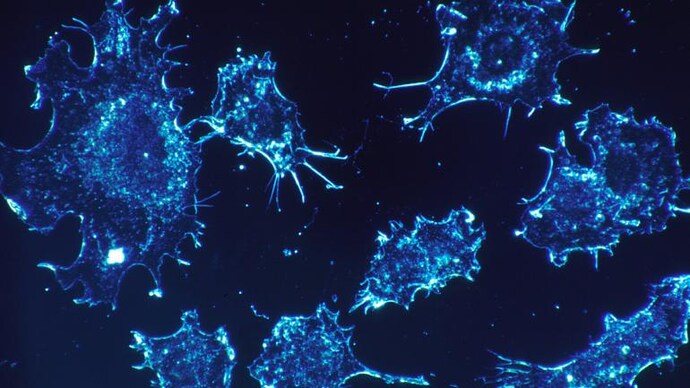This research by IIT Roorkee claims to detect and cure cancer economically
A team of IIT Rookree researchers led by professor P Gopinath have developed a safe way to detect cancer cells using carbon dots, which will stop the growth of these cells and treat cancer in a cost-effective way.

IIT Roorkee researchers have come up with a new way of detecting and treating cancer cells.
But first, let's talk about how cancer is the most dreadful disease one can have.
- Cancer is the second leading cause of death and disability around the world
- A large number of people die because of cancer than from all the cases of AIDS, tuberculosis, and malaria put together
- It has become one of the major causes of death in India. Every year, about 0.4 million deaths occur in India due to cancer (Government of India, 2010).
What's problematic is that most cases of cancer are detected only in the advanced stages, when they are untreatable. This is especially true in developing countries like India.
Cost of treatment
1. Cancer treatment in private hospitals is forbiddingly expensive in India.
2. Non-Hodgkin's lymphoma is a type of cancer that originates in our lymphatic system. Its diagnosis and treatment include lymph node biopsy, bone marrow test, an endoscopy, a PET scan, special anticancer drugs, and six cycles of chemotherapy.
3. All of this may cost around Rs 10,00,000.
4. The main reason is the staggeringly high cost of imported equipment for setting up a cancer hospital and expensive cancer treatment drugs.
However, IIT Roorkee has come up with a new way of detecting and treating cancer in an economical way.
Cancer, up until now was detected by using quantum dots that use toxic metals. These toxic metals are expensive to produce and break down when exposed to light. They can also cause some side effects during diagnosis.
A research team of P Gopinath, Uday Kumar and Bharat Bhushan developed a safe way to detect cancer cells.

The team is working on the development of various polymer based nanocarries for the delivery of several anticancer agents and also exploring the possibilities of different bio-compatible imaging agents for cancer diagnosis.
The researchers synthesised carbon dots by heating a solution of finely chopped rosy periwinkle plant leaves which when heated under controlled conditions yielded nanosized carbon dots.
What are carbon dots?
Carbon dots (C-dots) are light-emitting (luminescent) nanoparticles that can be used to track biological processes inside cells. They are less toxic than similar alternatives, making them more suitable to be used in live biological systems.
What is the difference between quantum dots and carbon dots?
There is not much difference between the two, except that quantum dot is a generalised term (nanomaterial of any kind), while carbon dot is a nanomaterial of carbon only.
Carbon dots are highly biocompatible and biodegradable.
What's interesting is that not all carbon dots are toxic. There are also synthesized carbon dots from other sources which are non-toxic.
"So, when we synthesize carbon dots from a medicinal plant like periwinkle, it will retain the toxic property," says P Gopinath, Associate Professor, Department of Biotechnology and Joint Faculty in Centre for Nanotechnology, IIT Roorkee.
When incubated with specific cancer cells, the carbon dots entered the cells.
These cells showed enhance fluorescence, indicating that the dots reached inside the cells. The dots selectively bound to microtubules (filamentous intracellular structures) that support cell division and help transport various molecules inside the cells.

A key property of these carbon dots is that they destabilise the structure of the microtubules and convert them into fragments, making the dots useful to stop the growth of cancer cells.
"Because of the fluorescence property, carbon dots can light up and we can also track the movement of the disease using carbon dots," says prof. Gopinath.
This is an economical and eco-friendly way to produce fluorescent carbon dots from the leaves of a common medicinal plant, adds Gopinath.
The IIT Roorkee research team is also developing methods wherein carbon dots could be targeted to cancer cells in particular.
"As this is nonspecific, it can target even the normal cells so when we devise a method to target the cancer cells, then we can spare the normal cells from this activity and we can kill only the cancer cells," says Gopinath.

Before choosing periwinkle leaves for this research, what were the previous resources you used to achieve the same result and why was periwinkle the most ideal?

"We have also done green synthesis of multifunctional carbon dots from coriander leaves and investigated their potential application as antioxidants, sensors and bio-imaging agents. However, they are non-toxic and do not kill cancer cells."
"A rosy periwinkle plant is already in use in ayurvedic medicine for treatment of various diseases. Therefore, we have selected this plant source and synthesized carbon dots from this which can kill cancer cells," Gopinath explains.
How will your research help in tackling cancer in India?
Therapeutic choices will be affordable and easily accessible in India.
"Our research aims to develop low-cost efficient anti-cancer therapeutic options. If this nanotag based approach is successful in animal and clinical trials, then it may be a low-cost nano-medicine to cure this dreadful disease," says Gopinath.
Have you approached hospitals and companies in India as well as abroad to adopt this technique? What have been the responses?
"We have to understand the complete molecular mechanism and investigate the therapeutic efficiency using animal models before we approach any companies. It will take another 10-15 years to get this drug into the market," says P Gopinath.
Also read | Government launches online cancer treatment tutorials for rural doctors
Also read | World Cancer Day: Facts about the disease responsible for almost one in six deaths globally

